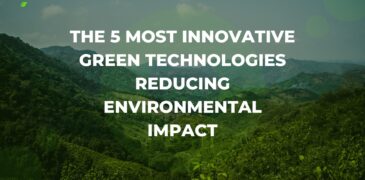Innovative green technologies are revolutionizing our approach to sustainability, offering solutions to mitigate environmental impact across various industries. From renewable energy sources to advanced waste management systems, these technologies prioritize efficiency and eco-friendliness. In this exploration, we’ll delve into some of the most groundbreaking innovations shaping the future of environmental conservation. These technologies not only strive to reduce carbon footprints but also pave the way for a more sustainable and resilient planet. Through their ingenuity and commitment to sustainability, they inspire hope for a greener future and demonstrate the potential for technology to be a driving force for positive environmental change.
Here are five of the most innovative green technologies that are making significant strides in reducing environmental impact:
1. Solar Photovoltaic (PV) Technology:
Solar Photovoltaic (PV) technology harnesses sunlight to generate electricity, offering a sustainable and renewable energy solution with a wide range of uses and benefits. One of its primary applications is in residential and commercial rooftop installations, where solar panels convert sunlight into electricity to power homes, businesses, and other buildings. Additionally, solar PV systems are deployed in utility-scale solar farms, contributing clean energy to the grid and reducing reliance on fossil fuels.
The benefits of solar PV technology are numerous. Firstly, it helps mitigate climate change by reducing greenhouse gas emissions associated with electricity generation from fossil fuels. Solar energy is abundant and inexhaustible, providing a reliable source of power while decreasing dependence on finite resources like coal, oil, and natural gas. Solar PV systems also offer energy independence, allowing homeowners and businesses to generate their electricity and potentially lower energy costs over time. Furthermore, solar installations create jobs in manufacturing, installation, and maintenance, contributing to economic growth and development.
2. Wind Turbines
Wind turbines are renewable energy systems that convert wind energy into electricity, offering numerous uses and benefits across various sectors. One of the primary uses of wind turbines is in utility-scale wind farms, where clusters of turbines are installed in windy locations, such as coastal areas or open plains, to generate large amounts of electricity for the grid. Additionally, smaller-scale wind turbines can be installed for distributed energy generation, providing power to remote locations, agricultural facilities, or individual homes and businesses.
The benefits of wind turbines are multifaceted. Firstly, they offer a clean and renewable energy source, helping to reduce greenhouse gas emissions and combat climate change. Wind energy is abundant and inexhaustible, providing a reliable and sustainable alternative to fossil fuels. Moreover, wind turbines create economic opportunities by stimulating investment, job creation, and local manufacturing in the renewable energy sector. They also contribute to energy security by diversifying the energy mix and reducing dependence on imported fuels.
3. Battery Storage Solutions
Battery storage solutions play a crucial role in modernizing the electrical grid and maximizing the efficiency of renewable energy sources. These systems store excess electricity generated during periods of low demand or high renewable energy production and discharge it when demand is high or renewable generation is low. One of the primary uses of battery storage solutions is to enhance grid stability and reliability by providing backup power during outages and smoothing out fluctuations in energy supply and demand.
The benefits of battery storage solutions are manifold. Firstly, they help reduce greenhouse gas emissions and combat climate change by enabling greater penetration of renewable energy sources. By storing excess renewable energy, battery storage systems reduce curtailment and allow for more efficient use of clean energy resources. Moreover, battery storage solutions enhance grid resilience and reliability by providing fast response times and smoothing out fluctuations in supply and demand. They also offer economic benefits by reducing energy costs, optimizing grid operations, and providing revenue opportunities through ancillary services like frequency regulation and demand response.
4. Eco-friendly transportation
Eco-friendly transportation encompasses a wide range of technologies and practices aimed at reducing the environmental impact of transportation systems. One of the primary uses of eco-friendly transportation is in the form of electric vehicles (EVs), which replace traditional internal combustion engine vehicles with electric motors powered by batteries or fuel cells. EVs offer a cleaner and more energy-efficient alternative to gasoline and diesel-powered vehicles, reducing greenhouse gas emissions, air pollution, and reliance on fossil fuels. Additionally, EVs can be charged using renewable energy sources like solar and wind power, further reducing their carbon footprint.
Another key component of eco-friendly transportation is public transit systems, including buses, trains, and subways, which provide efficient and sustainable alternatives to individual car travel. Public transit reduces traffic congestion, air pollution, and energy consumption, while also promoting social equity and accessibility.
Other eco-friendly transportation options include biking, walking, carpooling, and ridesharing, all of which offer low-carbon alternatives to driving alone in a personal vehicle. These modes of transportation reduce emissions, promote physical activity, and alleviate traffic congestion in urban areas.
5. Waste-to-Energy Technology
Waste-to-energy (WtE) technology is a sustainable solution that converts waste materials into usable energy, offering a range of environmental and economic benefits. This technology encompasses various processes, including incineration, gasification, and anaerobic digestion, which transform organic and non-organic waste into heat, electricity, or biofuels.
One primary use of waste-to-energy technology is in municipal solid waste management, where it helps divert waste from landfills, reduce methane emissions from decomposition, and generate clean energy. By incinerating or gasifying waste, WtE facilities can produce electricity or heat for local communities, contributing to energy security and reducing reliance on fossil fuels. Waste-to-energy technology can be applied to industrial and agricultural waste streams, such as biomass, sewage sludge, and agricultural residues, to produce renewable energy and reduce environmental pollution.
Conclusion
In conclusion, the most innovative green technologies are revolutionizing the way we approach environmental sustainability, offering solutions to reduce our carbon footprint and mitigate the impacts of climate change. From solar photovoltaic and wind turbine technology to battery storage solutions and eco-friendly transportation, these advancements are driving the transition towards a cleaner, more sustainable energy future. By harnessing renewable energy sources, improving energy efficiency, and promoting sustainable practices, these technologies are paving the way for a greener and more resilient planet. Through continued research, investment, and adoption, they have the potential to significantly reduce environmental impact and create a more sustainable world for future generations.
Read more:







